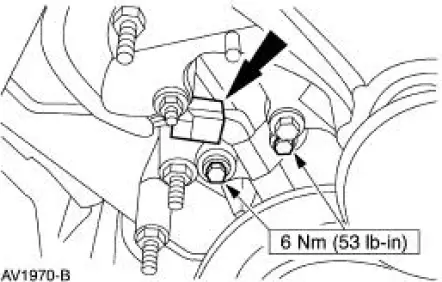Ford Mustang (1999-2004) Service Manual: Crankshaft Position (CKP) Sensor - 3.8L
Removal
1. Disconnect the battery ground cable. For additional information, refer to Section.
2. Remove the crankshaft position (CKP) sensor.
- Disconnect the connector.
- Remove the bolts and the sensor.

Installation
1. To install, reverse the removal procedure.
 Intake Manifold Runner Control (IMRC) Actuator - 3.8L
Intake Manifold Runner Control (IMRC) Actuator - 3.8L
Removal and Installation
1. Disconnect the battery ground cable. For additional information,
refer to Section.
2. Drain the cooling system. For additional information, refer to
Section.
...
 Crankshaft Position (CKP) Sensor - 4.6L
Crankshaft Position (CKP) Sensor - 4.6L
Removal
1. Disconnect the battery ground cable. For additional information,
refer to Section.
2. Remove the A/C compressor. For additional information, refer to
Section.
3. Remove the cr ...
Other materials:
Axle Housing
Special Tool(s)
Plug Set, Differential
205-294 (T89P-4850-B)
Protector, Differential Seal
(Pair)
205-461
Remover, Halfshaft
205-475
Remover, Steering Arm
211-003 (T64P-3590-F)
...
Underbody Misalignment Check
Underbody Dimensions
1. Underbody dimensions tolerances are +- 3.175 mm (0.125 in). Reference
dimensions are not
controlled dimensions. Reference points are +- 4.76 mm (0.1875 in). All underbody
dimensions
are detailed to the centerline of existin ...
Hydraulic Control Unit
Removal
1. Disconnect the battery ground cable(14301).
2. Disconnect the anti-lock-brake control module electrical connector.
3. NOTE: The 4 wheel anti-lock brake system (4WABS) with traction
control is shown , the
4WABS without traction control system is ...
